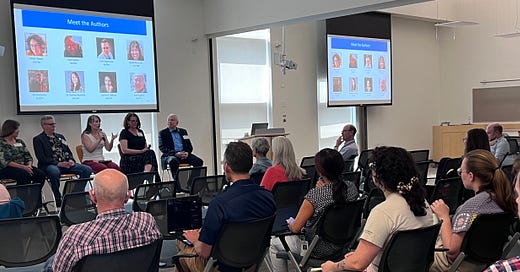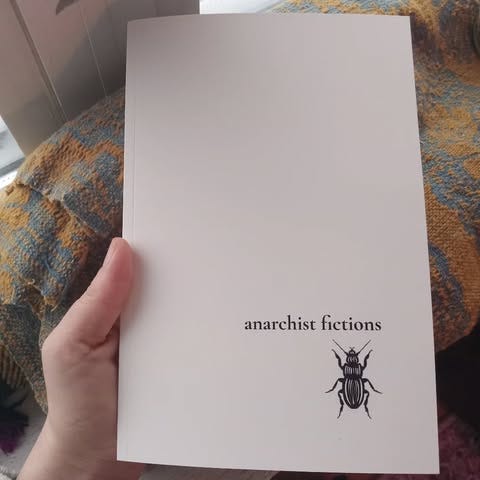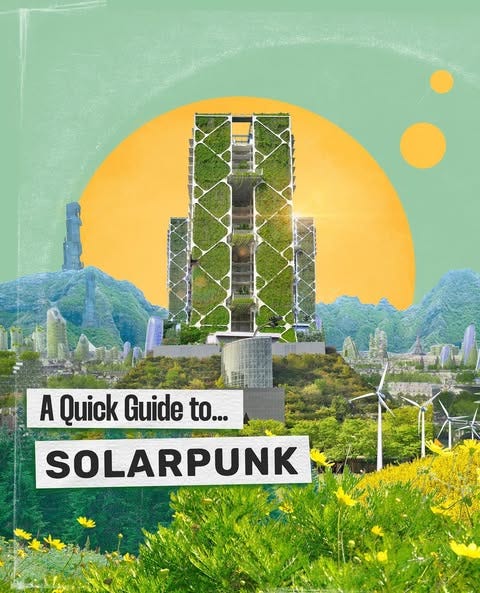Dear readers,
I have some writing wins to celebrate this month:
Some of you may remember my post from July about my first short story sale, “The Hydra vulgaris Self-Reassembly Experiment: An Anarchist Fairy Tale.” Well, that piece is now published in the first issue of Anarchist Fictions Journal, and I’ve included it at the end of this post along with an exclusive write-up of the “story behind the story.”
My first paid nonfiction story was recently published in Issue 21 of Imaginary Papers from Arizona State University’s Center For Science and the Imagination. This article covers the “Visioning Energy” workshop at the National Renewable Energy Laboratory (NREL) last August: a futurism brainstorming collaboration between eight sci-fi authors, including myself, and some of NREL’s renewable energy researchers, aimed at envisioning achievable descriptions of the world in the year 2100.
These days, each writing victory is bittersweet. I often feel torn between the excitement of hitting career milestones and guilt about my complicity in the crimes of the United States empire. It is infuriating to know that the taxes I pay this month will go to a treasury that our government is plundering to bomb children in Gaza (and elsewhere) as Israel—which is preventing aid from entering Gaza for the third consecutive week—additionally kills them by starvation, dehydration, and exposure. Yet, even knowing this, I still pay my taxes.
Every moment of celebration is likewise seasoned with my grief for what we are losing in the U.S.: social services, environmental safeguards, labor protections, job options, and a myriad of civil liberties, including (the illusions of) free speech and legal recourse. On a personal note, it’s surreal knowing that my PhD research—which was NIH-funded, cancer research-adjacent, and riddled with the no-no words “cis” and “trans” (in this context, relating to chemical structure)—could have been targeted by the ongoing attempt to cut certain types of NIH-funded biomedical research. It’s also sobering to know that book bans are ever-expanding, and could one day affect my books. And yet these concerns feel trivial when so many others who lack my structural privileges are facing—and throughout U.S. history, have always faced—imminent threats to their health, safety, and liberty.
Here’s where I have been finding hope and strength:
volunteer work (labor organizing support)
mutual aid network- and community-building activities like friend & neighbor group meals
learning new skills (e.g., gardening, chicken raising, sewing) that enhance community resilience against supply chain disruption and the rising cost of basic necessities
I’m planning to share more in April about these activities, which endow me with the necessary hopefulness to write fiction set in optimistic (yet, achievable) visions of the future. Which brings me to…
My first paid piece of science journalism: a write-up on the National Renewable Energy Lab’s “Visioning Energy” workshop

I wrote an article about last summer’s “Visioning Energy” workshop at the National Renewable Energy Laboratory (NREL) for a publication called Imaginary Papers—and I got paid for it! Shout-out to Andrew Dana Hudson (a climate-fiction author; you can read some of his stuff here!) who facilitated this opportunity by connecting me with the editor of Imaginary Papers, Joey Eschrich at Arizona State University’s Center For Science and the Imagination. Shout-out to Joey as well for being such a great editor.
You can read my article here by scrolling down to the section “Imagination Elsewhere.” This story describes the workshop from my perspective as one of the participating sci-fi authors, and provides some examples of the year 2100 scenarios produced during this NREL researcher-SF author brainstorming collaboration. I end the piece on this note:
Through my work in labor and tenant organizing, I’ve learned that one of the greatest hurdles to creating positive change is helping people believe they deserve better—and showing them that better conditions are truly possible. This is where hopeful science fiction plays a crucial role, especially when it’s grounded in technological reality. That’s why this new collaboration between sci-fi authors and energy researchers in Colorado is so promising. To build a brighter future, we must first be able to envision it.
Both my novels-in-progress, THE GHOSTS OF GADOLIN (which I co-wrote with Sam Clamons) and the new mermaid sci-fi romance I mentioned last month, take place a few hundred years from now in hopeful visions of the future. However, since I can’t yet share my novels with you, I want to recommend this book that’ll scratch that itch for a good story that takes place in a brighter future:
Everything For Everyone: An Oral History of the New York Commune, 2052-2072 is the most realistic futurism fic I’ve come across. It contains no illusion that there’s a safe and easy way to reform society into something more equitable and sustainable—this book doesn’t shy away from the horrors of societal collapse that must be lived through on the way there. But given all that’s going on in the world, it’s an encouraging read: it offers a convincing argument that there may be light at the end of this tunnel.
To find more books that feature positive futures, check out this list from Bright Green Futures and explore the “solarpunk” genre:
And now, the story you’ve been waiting for…
“The Hydra vulgaris Self-Reassembly Experiment: An Anarchist Fairy Tale” by yours truly
“A revolution on a world scale will take a very long time. But it is already starting to happen. Revolutionary action does not necessarily have to aim to topple governments. Attempts to create autonomous communities in the face of power are revolutionary acts. And history shows us that the continual accumulation of such acts can change (almost) everything.”
― David Graeber, Fragments of an Anarchist Anthropology
We are the common Hydra. We are invincible.
In Hydra, every cell has work and none goes wanting. Our foot anchors us to the river rock. Our tentacles hunt. Our hollow body column—two cells thick—digests our prey and distributes nutrients. From each according to their ability, to each according to their needs. Hydra takes care of Hydra.
Our muscles contract; our neurons communicate. We feast on water fleas. Our arms gently sway in the freshwater current. When it’s time to travel, our body bends over, our tentacles grip, our foot detaches. Head over heels, we cartwheel along the streambed’s stones, plants, and organic debris.
God wades into the water with a Pasteur pipette. He squats to turn over stones, leaves, and reeds, and finds Hydra on the underside of a waterlogged branch. He detaches them by aspiration and transfers them to a dish full of strange liquid. He takes them to the lab.
The world changes around Hydra. Small, oblong suns emit harsh light—sometimes, even when it should be dark. The water is mostly still. Every other day, there are brine shrimp larvae for us to hunt, but where have the water fleas gone? Where are the worms, the tiny fish? Why are there no rocks and sticks to somersault over or hide beneath?
God puts on a white coat and peers through the microscope’s eyepiece. Day after day, He studies Hydra. Yet, they do not wither or weaken. Years later, they catch brine shrimp as spryly as the day He found them in the stream.
God can deny it no longer. Hydra is immortal.
“How has this creature evolved to escape death?” He asks, pacing back and forth across the lab. Will His creation never cease to defy Him? Hydra dares to live forever, to become a god… How has it come to this?
God considers that Hydra may not have learned their lesson during the Great Flood. They must have been quite at their leisure, cartwheeling under all that submersed debris.
Still—what hubris! What conceit, that these cells should build themselves a tower, whose top may reach heaven! It is not right. All good animals should die.
Finally, God has an idea.
“They are all one organism,” says He, “and they have all one language, and nothing they propose to do will be impossible for them. Come, let us go down and confuse their language, so they will not understand one another's speech.”
His Pasteur pipette glints under the fluorescent lights as he lowers it toward Hydra’s dish. His finger muscles twitch in anticipation of the vigorous resuspension protocol.
Hydra is divided, torn apart and scrambled. Who are we, now? We do not recognize ourself. Tentacle cells live among us, yet we have no tentacles with which to hunt. Mouth cells are accounted for, yet we have no mouth with which to eat. We have no body cavity for digesting water fleas, nor a foot to moor us.
Our cellular diaspora huddles in tiny clusters to grieve with fellow strangers. Each cell grows more arms to hold each other tighter. One among them starts to sing. Others join in—hesitantly, at first. They sort themselves into sections: bass, alto; endoderm, ectoderm. They raise a chorus of synchronized neural activity.
Neighboring cell ensembles cautiously convene. They learn each other’s languages and find common ground. They combine voices and harmonize. Their neurons pulse in a unified circuit, bridging the local groups.
Hydra is getting organized. Gradually, our constituent communities connect. Trust grows, and something like a body axis emerges. Tentacle nubs appear. Cells of Hydra, unite.
We conduct a structure test: contraction. A coordinated pulse of neural activity traverses our entire aggregate. Communication is restored!
We have brought to birth a new world from the ashes of the old.
God’s fingers tremble on the microscope’s focus knob. Hydra’s tower has risen once more. In just three days they laid the wide foundations, built it skyward cell by cell.
“They do not need me,” He whispers. Yet, He still needs them. What is God without His creation? What is a king without his subjects?
What is the parasite without its host.
Reluctantly, God returns Hydra to their stream. He folds up His lab coat and sets it on a log, then sits beside it and places His feet in the water. As the gentle current flows around His ankles and between His toes, a red leaf flutters on the breeze and alights on the placid surface. God thinks of how much the Hydra will enjoy somersaulting along that leaf when it sinks. He smiles, despite Himself.
Creation is rebellious, yes. But beautiful.
God’s feet slowly disintegrate—then, the rest of Him. The wind and water carry His flesh downstream. His nutrients are consumed by organisms great and small.
Like a good animal, He dies.
Worms! Bugs! Fish fry! Daphnia! Bread and Roses.
It is good to be home.
We birth Hydra babies. They bud off from our body column and flip alongside us, then cartwheel off into the glorious muck. What pleasure it is to suction ourself to slimy, decaying wood. What fun, to hunt and fish!
Our cells, united, can never be defeated. We worship no gods; we serve no masters.
We are the common Hydra.
Thanks for reading! If you’re interested in buying the full issue of Anarchist Fictions Journal, in which my above Hydra story was first published last month, you can email the publisher at anarchistfictions@proton.me.
Last thing, a quick reminder: the “Springs Book Bash” is coming up on April 26-27 in Colorado Springs—don’t forget to reserve your tickets, and I hope to see some of you there!
Love,
Rachael
P.S. For the curious, here’s my write-up of the inspiration behind my Hydra story…
The story behind “The Hydra vulgaris Self-Reassembly Experiment: An Anarchist Fairy Tale”
As a cellular communication researcher, I tended to personify the cells I worked with. For example, this stromal cell instructs that hematopoietic progenitor, in the language of Notch signaling, to differentiate into a T cell… and so forth. So, when I learned—from Werner Herzog’s neuroscience documentary Theatre of Thought—how aggregates of blended-up hydra cells can reassemble themselves back into a normal animal, I saw a story about the power of organized people.
Parallels between the hydra self-reassembly experiment and the Tower of Babel myth proved irresistible: a (tower-shaped) animal is scrambled up and its constituent cells scattered to all corners of the organism, disrupting intercellular communication? Then, I realized: the biblical myth lacked an ending. The people of the world didn’t stay in our own corners of the world. We traveled, learned each other’s languages. We invented long-range communication technologies. We started local and global movements for justice and liberation. Today, we humans, like the blended-up hydra, are getting organized.
But who is the story’s villain? The white-coated God-scientist is any Authority who needs us but is not needed by us, who seeks to divide us because He fears our collective power. You may see the capitalist, the corporate boss, the politician, or even a deity. However, I couldn’t help imbuing God with a bit of hydra biologist Daniel Martı́nez. In an interview with NPR, he said, “I set out to prove that hydra could not be immortal because I believed that that was not possible and that any animal… you know, like a good animal, hydra should die.” Yet, Martı́nez failed to disprove hydra’s immortality, and ultimately published his capitulation, “Mortality patterns suggest lack of senescence in hydra,” in 1998.
Thus, the story of hydra self-reassembly became an anarchist fairy tale. Hydra’s cells got so organized and self-sufficient that they defeated the ultimate Authority by rendering Him obsolete.
Humanity faces an existential crisis as our Authorities abuse our life-support system, the Earth. Our survival depends on how we write the ending to our own Tower of Babel myth. But, I am hopeful. Because, just as God feared: if we become one people, and we all work together, nothing we propose to do will be impossible for us.







